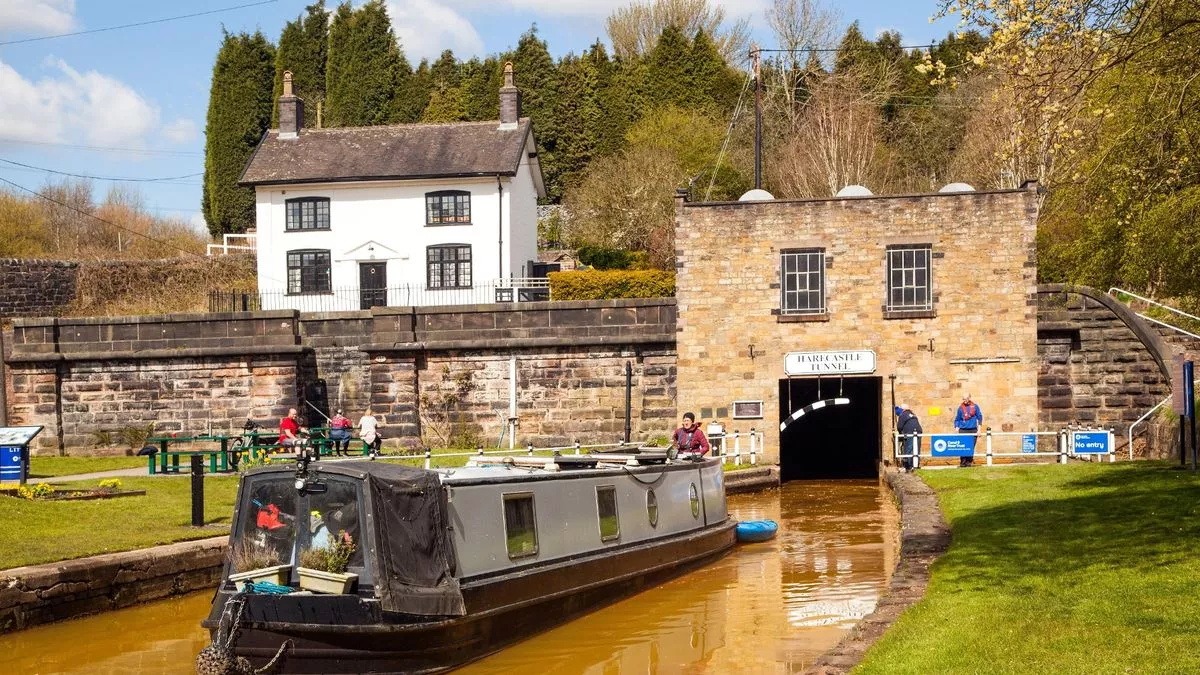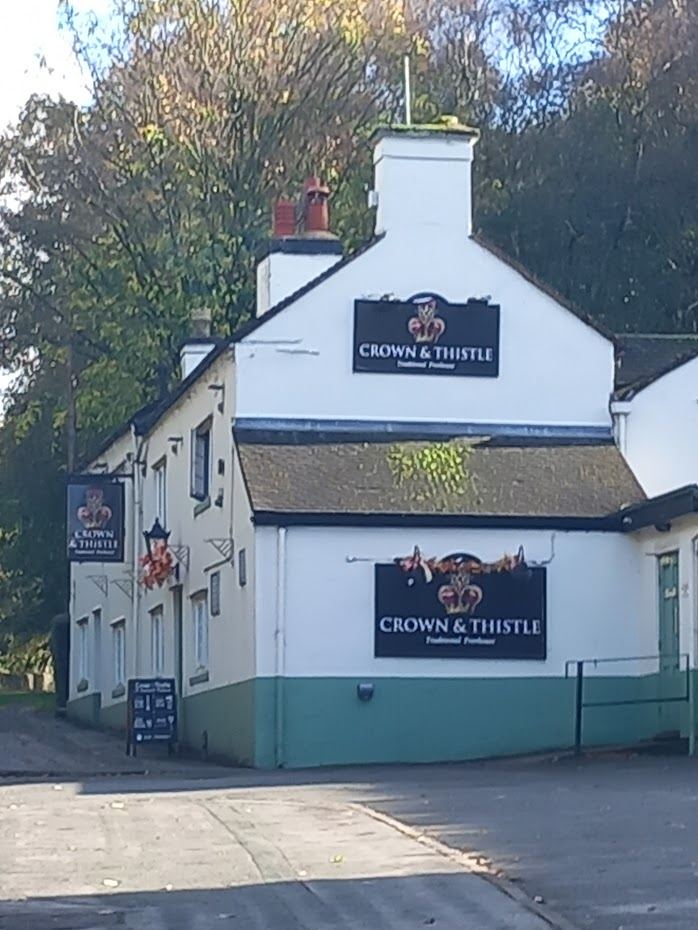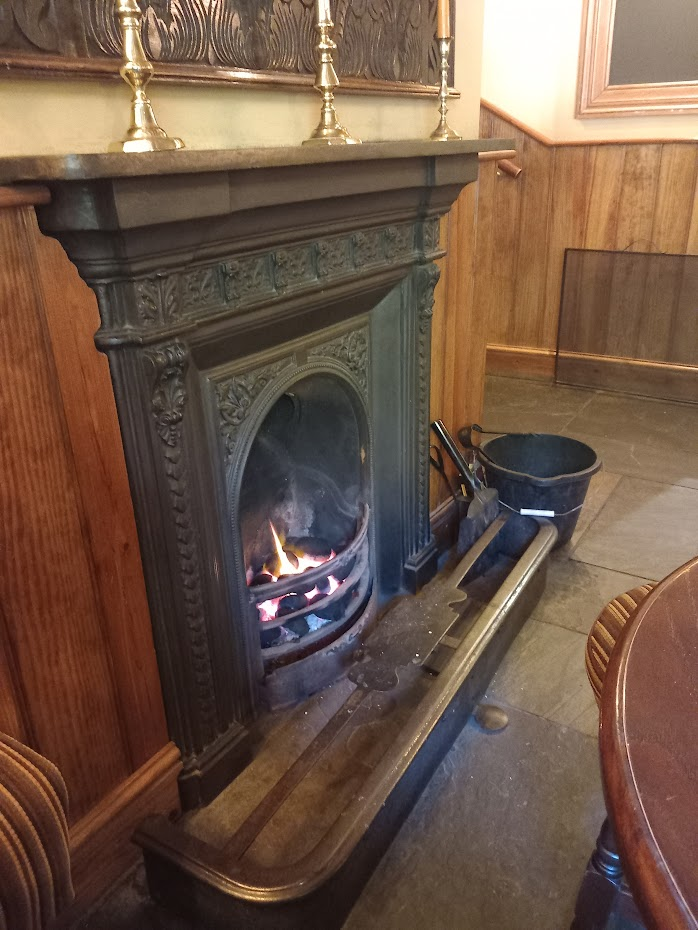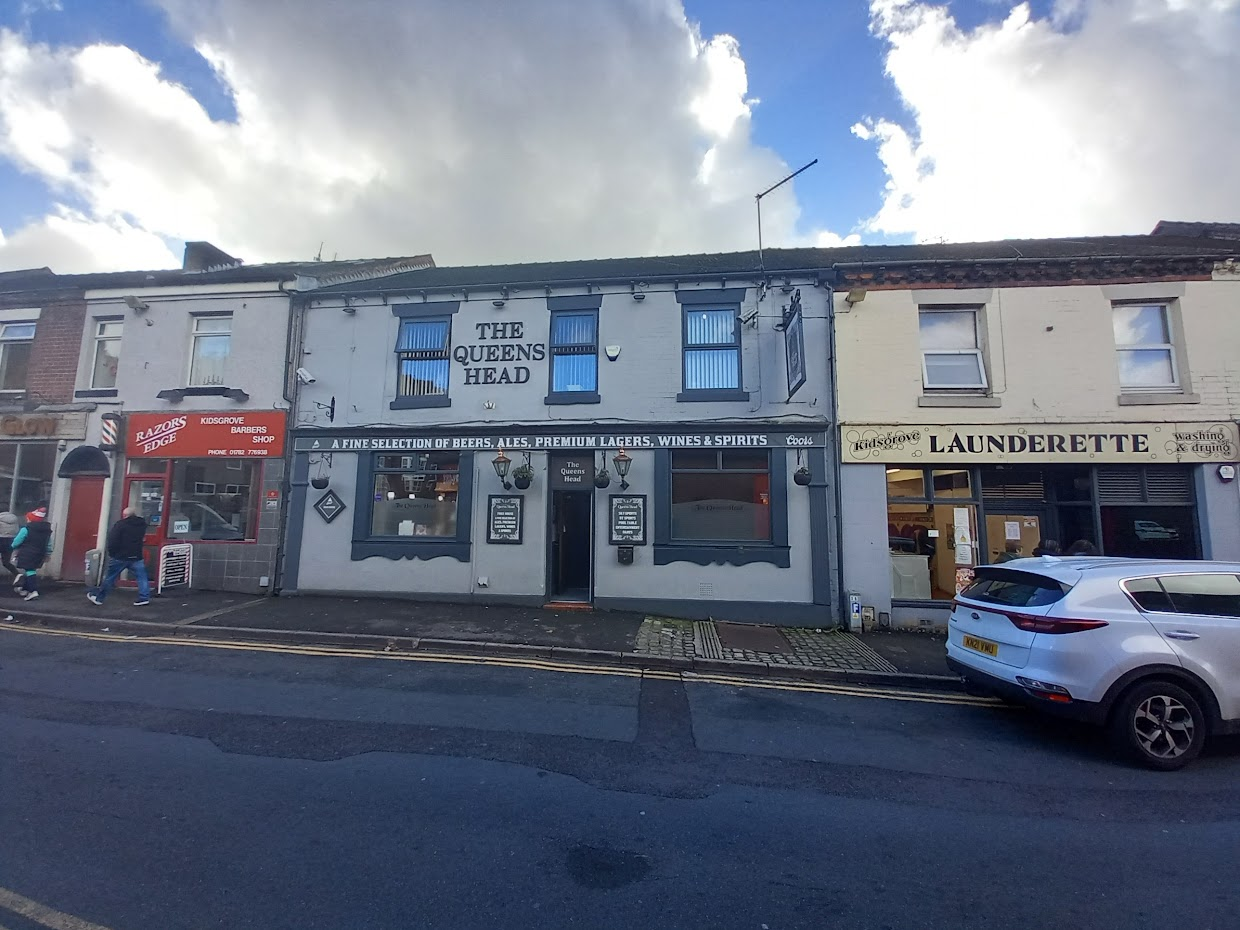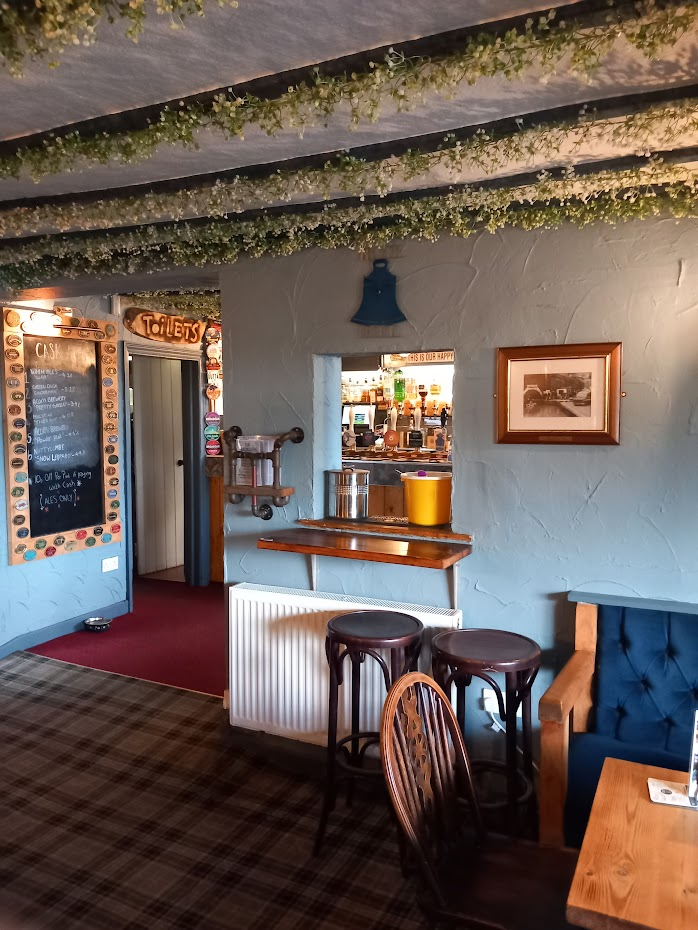Searching for Boggarts,
Canal pioneers, spitfires and a decent pint – a beery ramble around Kidsgrove
Hoping to squeeze the last day out of the Bus fare cap scheme –
which in the Potteries area means all day unlimited travel on all bus providers
for a very reasonable £3:50 I landed another day on the buss travel to another border
area of the Stoke Smart Zone – the former pit town of Kidsgrove - though that was the plan the fares had
actually gone up the week before – bus fares are continuing to be subsidised, as
part of the Affordable Fares schemes, but at a slightly higher price – the day
ticket going up to £4.80 which wen compared the price of most metropolitan pints
these days is still reasonable.
Kidsgrove is a strange little town often by passed by those on
Road Rail and canals- The town, greedily has two, the Trent and Mersey emerges
from the 1.6 mile long Harecastle Tunnel – a rather alarming orange colour
which felt very autumnal here in October and the Macclesfield canal has it southern
terminus in the town handily the junction where the two canal meet is overlooked
by a very fine pub.
(The canal’s orange tinge in this area is due to a natural discolouration from groundwater containing iron oxide leaching into the canal.)
Kidsgrove is derived from old English ‘Kid crew’, which the town was known as until around 200
years ago, Crew was a pen or stall for animals – some historians claim it was
calves that were held in these pens, others suggest that the animals in
question were Goats! There are actually a surprising number of pubs in the town
and immediate subsurbs, probably due to the fact that in its more recent past, this
was very much a pit town in the 19th century, sadly all the pits
have gone now and most residents commute south the Potteries or north to
Macclesfield and Manchester.
The Spitfire connection comes from Reginald
Mitchell, born in the town, who was the chief designer of World War 2’s most
famous fighter plane The Spitfire – though most of his work was done down in
Southampton. Whist there are a number of spitfire links around Kidsgrove and
the wider potteries (Including a Wetherspoons named after him in Hanley) there
are no Kidsgrove pubs named after either Mitchell or the Spitfire.
The town also benefitted from the birth and
development of the canal network, canal pioneer James Brindley working down the
road in Burslem cut his teeth on designing and building the Trent and Mersey
which opened up global markets for the potters of Stoke, he cut the first nearby
Harecastle Tunnel in the late 18th century, though the tunnel now
used by the canal was actually designed by another renowned engineer Thomas
Telford in the 1820’s – the tunnel is said to be the home of the Kidsgrove
Boggart but more of them later.
Having walked down into Newcastle Under Lyme on
a please October autumnal morning I got on the first bus of the day – a rather circuitous
39 route that would take from Newcastle through three of the six Stoke towns
(Hanley, Burslem and Tunstall) before around Hour later dropping me in Kidsgrove - the route then carries on anti clockwise
winding through the former pit villages of North Staffordshire before arriving back in Newcastle under Lyme and it was this
circular route I was going to follow.
I do love how our
local bus company First Potteries celebrates our city heritage, the orange
buses all have a Minton tiled decor on their floors and other images and
information about the city throughout the bus. It was a quiet and subdued bus
mainly single folk of an age who have been out
early to do their weekly shop. All
gazing one bloke tries to engage in conversation but no body is taking him on
I’m. Bit too far back
Got a bit lively at Hanley bus station and a change of driver
though our new drive entered the bus late flustered and effing and Jeffing, he
cheered up a bit when the retiring
Driver told him we’d all been boarded!
Hanley folk proved to be a little more chatty and the bus fills up
as we head north through
Burslem and then Tunstall
The Cadmore advertising info
describes the CnT as “a rustic Countryside pub” despite it being pretty much
opposite a Lidl, it’s however a very nice welcoming pub – all spic and span but
with open fires and a good reputation for good ales, it was apparently left abandoned
for a while before Cadmore took it on so they do deserve some credit for what
is now a lovely pub and served me probably the best (out of around 13) pint of
the day.
As mentioned above it was
previously known as Brennans I’m assuming after the then landlord. It looks to
have a fair bit of heritage so could assume Crown and Thistle was it’s original
name, it is quite a unique name apparently there are only 4 pubs in the UK with
this name, which is said to refer to the union of England and Scotland in 1707.
I actually had to walk passed another pub after alighting from the bus, the Plough which did look welcoming and one I will need to come back to. As I entered the Crown the only other punter was leaving which meant I had the multi roomed pub to myself so was able to take up prime position next to the glowing coal fire.
An interesting choice across four of the six cask pumps - three local brews, an MBH, Storm and a Wincle - Hanging Stone Porter which looked new, the four choice was a Tiny Rebel Catch which is slightly less ubiquitous these days as it one was, after a little hesitation I went with the Storm Brewing Bosley Cloud at £3:90 a pint. The friendly bar did give me a taste of the Wincle porter which was ok but glad I went with the Bosley Cloud it was on top form and certainly set the days beer tariff very high.
I did share the fire with one other pub dweller a rather gruesome looking Halloween scare crow – which apparently had scared the bar lady witless when she’d walked in first thing this morning, she was not looking forward to along day she’d opened up at 11:30 and would be on till 9pm, she said it would pick up later but was always very quiet Saturday lunchtime.
I set off back down the hill and past the Plough and the rather
elegant Victoria Hall, based for the local council but also a small venue and
one that does have a public bar which does offer a range of craft beers
apparently. Kidsgrove town centre is certainly quirky it runs parallel to the
main through road the crown and Victoria Hall sit on but is really a single
side street of
hairdressers vape and charity shops a smattering if kebab shops with the pub in
the middle and BnM on the other side of the street.
The pub in the middle is the
Queens Head reported to be much more of a locals pub and a bit more spit n
sawdust, a central corridor leads you to a bar and large room to the left, a
pool room to the rear and an interesting (in my mind anyway) snug style room to
the right.
Whilst not quite spit and sawdust it’s a basic boozer inside, but
was very busy in the main room mainly extended families sat around the big
screen showing the Tottenham V West Ham match and a few more in the pool room.
I sought sanctity in the small snug room stepping back in time to the Golden Lion
of Malton where
I cut my beer teeth 30 odd years ago.
Bass was the only cask on offer and with Cruz Campo being the
nearest craft choice o the bar I noticed quite a few supping Guinness so went
with that and was duly present with a fine pour and wait pint with a good doom
and value at £4 a pint (
I didn’t split he G which is the current
apparent trend and link to somewhat of resurgence in sale of the back stuff)
but sipped gently all on my own in the front room.
 |
| Inside the Queens |
 |
The next port of call required a bit of a trek up past Tesco’s and the train station passing the wild west looking railway inn and the Canal Tavern – the Blue Bell is a bit of a beery destination and as for many years had a reputation for both the choice and quality of its cask beers. Despite passing it many times on the water when we had a canal barge, it’s a pub I have never visited previously
Built in 1836 probably at the height of the canal boom it sits strategically
where the Trent and Mersey meets the Macclesfield canal and just north of the Harecastle
tunnel which even diesel driven canal boats still take a thirsty hour to get
through. The pub sign above the door has an interesting story, the pub was tied
to Dix brewery of Shelton and the brewers name was originally on the bottom of
the concrete pub sign, but when Dix was bought out by local rivals Parkers of
Burslem, someone was sent up to chisel the Dix brewery lettering off the sign. Parkers
and its pubs were themselves taken over by Ind Cooper in 1949 and was renamed
the Ansell’s Burslem Brewery.
As expected there was a good range of cask beer on offer 2 from
Acorn of Barnsley, a Nuttycombe new brewery for me, which I initially read as
Buttcome, a Bear Town and a Green Duck – Millstone was listed on the beer board
but had just gone off.
I went with the Nuttycome Snow Leopard which was very nice a pleasant blend of sweet and citrus, quite refreshing after my trek to the pub. Nuttycom brewery is based down in Taunton, so this beer was a long way from home and little more research finds they are an offshoot of the more established Cotleigh brewery whose Tawny is a twice GBG beer of the year and national finalist in the Champion beer of Britain.
Having been the only drinker suddenly inundated with a group locals
on a canal towpath pub crawl and then a gaggle of braying lovelies all Pippas
and Nigels fitted out in flat caps, fisherman smocks and fake furs – though they
did return their glasses to the bar when they left though. My particular
high point of their visit was one
of the red faced bank manager type males bellowing Millstone Millstone, Millstone
I want a millstone till he found out it was off and then debating whether the
draft Staropramen was brewed in the UK or shipped in – I nearly directed then
to a beery podcast that had covered this very topic last month but kept quite
and thankfully the bellowing group went to sit outside in what had turned out
to be a nice afternoon of autumnal sunshine and blue skies.
One final part of the boaty crew, when presented with their bill
for their round of drinks they were gobsmacked that it was only £35 and loudly
shouted that it would have ben nearer £100 in London. Taking of money I did notice
that on the beer board its said that there was a 10% discount on drinks when
paid in cash – a sign of the growing challenge of card charges pubs
face – we were speaking about this to Grum the landlord at our local the Bridge
Street Ale House in Newcastle under Lyme – he reported that he had paid £3,000
ibn card charges in the last financial year – he doesn’t offer a discount but encourages
people to use a tab and pay the total off
at the end as this works out better for card transactions.
So on my next visit to the bar I splashed the cash, I had asked for 2 halves of each of the Acorn beers on offer Pretty Green and Powder plot which I assumed were seasonal s with the Hop harvest season upon us and the upcoming Bonfiore night, but ended up with 1 Acorn and a Beartown Kodiak – which I didn’t mind too much as as I do like Kodiak
I was now faced with a bus
dilemma do I head off and try and catch the next bus due in 10 mins or sit back
have another and get the one in 37 minutes – not quite knowing ho long it would
tale me to walk the next stop I of course did the latter and went back to the
bar but made the school boy error of going for the seasonal autumnal special Green
Duck Cinderman a 5.2% stout - which came
presented in the style of a 90’s beer festival flat murky liquid with too much sniff and not much taste.
I had better mention the Boggart who has been spooking folk for over 200 years, Legend has it the boggart is the spirit of a woman who was murdered by boatmen as she travelled to London by canal barge through the Harecastle Tunnel The sighting of her headless ghost is thought to mean doom and disaster – and it is said she was seen on the morning of many of North Staffordshire’s worst mining disasters. An article in the local Sentinal newspaper in October 2020 however challenged this version of events suggesting that this version of the myth has become confused with the very real murder of Christina Collins in 1839. She was travelling by barge from Liverpool to London, and was indeed killed by boatmen, who threw her in the Trent and Mersey Canal, but the murder actually took place not at Kidsgrove, but at Brindley Bank, near Rugeley. Nor did she lose her head. In fact the legend of the Kidsgrove or ‘Kitcrew’ Boggart was already a well known folk tale by the time poor Christina was murdered.
According to a much earlier Sentinel report of 1879:
“The tale of the origin of the boggart which found the most general belief was
that one of these boatmen, while passing under the tunnel, quarrelled with his
wife and, for some provoking words which the woman used, he cut her head off. “Afterwards,
to conceal the murder, he dragged the body into the colliery working’ Many
boats entering the tunnel will be aware of the tunnel and rather naughtily someone
has drawn a florescent skeleton on the wall of the tunnel about half way – having
done it a few time sI can vouch it is an eerie passage the tunnel is long and
with a kink t in you can see either end and these day they also close ventilation
doors behind you on entering, its pretty wet and gets quite narrow and low towards
the middle – not for the faint hearted – thankfully there were no sights of boggarts
today!
Back on the bus to head to another place with unique name and equally intriguing history Talke,
mentioned in the Domesday book as Talc in 1086, the name is derived from the even more amazing ‘talk o’ the hill’ which actually means bush on top of the hill – couldn’t find a bush but there are still three pubs in the village again probably something tomdo with the local colleries, street names such coal pit hill and Talke pits suggest a local population who would have a thirst.
A report on the village written in
1912 states that Talke has three public houses, The Swan, The Caldwell Arms and
the Old Queens Head and I wouldn’t be surprised if these three pubs were still
around in a hundred years time
Else where in that report, it also
states that there were a further six beer retailers in the village as well as
the pubs. There were two main collieries in the area Talke ‘o th’ hill colliery
(where the modern retail outlet mall now is) and Bunkers Hill colliery, both
became known nationally due to tragic accidents.
An explosion at the Talke pit in
1866 killed 91 miners, Queen Victoria was so moved she set up a bereavement
fund for affected families, a similar fatal explosion also killed 43 miners at
the Bunkers Hill pit in 1875.
All three pubs do still exist
though the Caldwell Arms is now the Caldwell Tavern. The Swan and Old Queens
Head are actually neighbours in the centre of the village.
The Swann
pub is the most prominent again very close to the bust stop and it was here I
entered first, my notes record the following – , Have got to say the staff and clientele were fine and it was good to see it
relatively busy but its just carnivorous hard atmosphere and very strange
furniture more of a Indian restaurant trying to be high end
 |
| In the Swann |
They did have Pedigree and Empire IPA on cask, Ive gone off Marston or rather Carlsberg in light of recent
shenanigans but on a whim I settled for a Pint Marstons
smooth on Keg which was OK and at cheapest pint of day so far £3:65. My Untapped review states the
following
Does what it says on the tin - actually wasn’t bad kept its head left slaking down the glass and consistent mouth a little cold but ok at least£3:65 cheapest pint of day so far
Earwigging the conversation around the bar the couple behind the
bar were new landlords still wrestling with the Wi-Fi,
till and cellar. The old boys sat around the bar were
at least drinking cask despite their sleeveless black vest and tats, Im
guessing they were ex miners
who had been coming to the Swann for many a year.
The Swann has a rather sinister story and as yet still unresolved,
in 1920 the landlord Walter Hulse was shot dead with his own shotgun in the pub
in the early hours, his wife was upstairs and initially a recently fired bar
man James Linney was accused of the murder but was acquitted in court and the
case has never been solved.
The Old Queens
Head tucked away to the left of the Swann looked closed initially, with no
lights or anything on but on closer inspection it was open and I met the bar
lady outside having a fag so I bode her to take her time and walked into what
was another quiet pup with one other couple sat by a crackling open fire. When
I say quiet it wasn’t quite true as the large TV in the corner of the room was
tuned to an 80’s Music channel, so beer was supped to a back drop of Depeche
Mode and Bonny Tyler. Three cask were on
offer; Atlantic Pale and tow Timothy Taylor’s Landlord and the less seen Golden
Best (On of my face beers of all time especially supped in Taylors unofficial
Tap the Boltmakers in Keighley though sadly as with most heritage beers no
where near to beer of my youth these day) very much a Brucey bonus £2:75 and it was OK
and the strains of Chris de Burg singing lady in red on the TV almost took me
back to those melancholy days in Keighley.
Compared to Swann this shoud be the village pub, good beer,
heritage, a wall devoted to Stoke City and England goal keepers (Mainly Gordon
Banks and Peter Shilton) The Barmaid sat having a chat with what i assume were
a regular couple I
moved on to a pint of Landlord at £4:40 a pint and for a
while was the only drinker –
though it did fill up with a few more punters as I went back to into 3 another
Golden Best.
 |
| The Old Queens Head |
 |
| Goal Keepers Corner |
The plan had been now to jump back the bus and head to Red Street the next village down the route and another with an interesting name. A local myth suggests the name stems from a bloody and violent battle fought here in the English Civil war but records suggest the nearest battle between Roundhead and Loyalists was over 20 miles away. When the local BBC team looked into the mystery behind the name in 2017, Andrew George the principal archivist at the Staffordshire Records Office reported that some sources suggested the name came from a struggle between Saxon and Danes in the 9th Century.
This village is famous for it manufacturing of tiles and brick and the Wedgewood memorial just outside the village which is visible from the nearby A500 and M6. There is however a twist in that this memorial is not dedicated to Josiah Wedgewood pot maker of stoke but John Wedgewood (Undoubtedly part of the extended W family) 1760 -1829 a local pit owner – he actually wanted to be buried underneath the memorial but is actually buried in nearby Audley church yard. Another interesting fact is that the current memorial is a little stunted and only 1 quarter of the original obelisk which was blown over and broken during a particularly furious storm in 1976 (it had been erected in 1850 - so had done bad). The intended target in Red Street was the Crown (note the fourth pub of the day with a Royal link). What Pub description describe sit as a redbrick two roomed Victorian pub which runs its own football team and where Fresh baps are available! – my type of pub – however wife and sister in law just happened to have finished a shopping spree to nearby Talke Retail outlet and the thought of a speedy return back to Newcastle and the chance to complete the day with a quick ramble around my three locals won the day and that how the day ended with a pint the Bridge Street Ale House, Hopwater Cellar and finally Mellards.
 |
| A time to reflect in the Bridge Street Ale House beer garden |
All in all a good day with some interesting and returnable pubs –
best pint of the day was undoubtedly the first a Storm Bosley Cloud in the Crown and Thistle which I would highly recommend
would probably want to go back to the Blue Bell perhaps for a summers evening
session and will one day, go and try one of those baps at the Crown in Red
Street.
